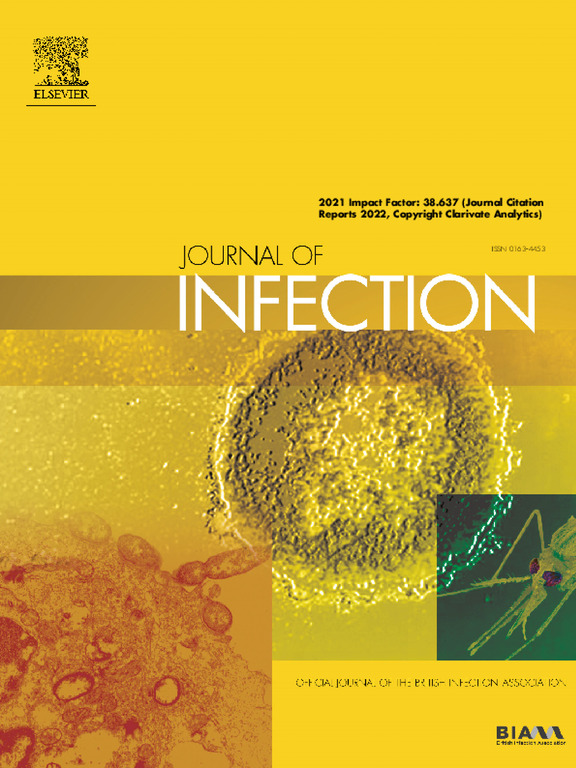新一代宏基因组测序在抗菌素治疗后血液感染的血液恶性肿瘤患者中的诊断价值。
IF 14.3
1区 医学
Q1 INFECTIOUS DISEASES
引用次数: 0
摘要
背景:元基因组新一代测序(mNGS)是检测血流感染(BSI)致病病原体的有效方法。然而,关于抗生素的使用是否会影响 mNGS 的诊断效果,目前还没有达成共识。我们开展了一项前瞻性临床研究,旨在评估抗菌治疗对 mNGS 的影响:方法:在培养确诊为 BSI 的 24 小时内采集血样进行 mNGS 检测,每 2-3 天复检一次:结果:共纳入 38 例 BSI 患者。使用抗生素后,mNGS 阳性(mNGS-pos)率急剧下降,只有 17 例(44.78%)患者仍为 mNGS-pos,其余均为 mNGS 阴性(mNGS-neg)。与血培养(BC)相比,mNGS 病原体鉴定的中位持续时间明显更长(4 天 vs 1 天;P < 0.0001)。阳性持续时间≥ 3 天是脓毒性休克的独立风险因素(OR,20.671;95% CI,1.958-218.190;P = 0.012)。mNGS-pos和mNGS-neg患者在发热中位持续时间(6天 vs 3天;P = 0.038)、耐药率(35.3% vs 4.8%;P = 0.017)、脓毒性休克发生率(47.1% vs 14.3%;P = 0.029)和28天死亡率(29.4% vs 4.8%;P = 0.041)方面存在差异:结论:抗菌治疗将大大降低 mNGS 的阳性率。结论:抗菌治疗将大大降低 mNGS 的阳性率。mNGS 持续时间长表明脓毒性休克的风险增加,可确定为不良感染结局的高危因素,需要采取更积极的抗感染治疗措施。本文章由计算机程序翻译,如有差异,请以英文原文为准。
Diagnostic performance of metagenomic next-generation sequencing among hematological malignancy patients with bloodstream infections after antimicrobial therapy
Background
Metagenomic next-generation sequencing (mNGS) is an effective method for detecting pathogenic pathogens of bloodstream infection (BSI). However, there is no consensus on whether the use of antibiotics affects the diagnostic performance of mNGS. We conducted a prospective clinical study aiming to evaluate the effect of antimicrobial treatment on mNGS.
Methods
Blood samples were collected for mNGS testing within 24 h of culture-confirmed with BSI, with re-examination conducted every 2–3 days.
Results
A total of 38 patients with BSI were enrolled. The mNGS positive (mNGS-pos) rate declined sharply after the use of antibiotics, with only 17 (44.78%) patients remaining mNGS-pos while the rest were mNGS negative (mNGS-neg). The median duration of pathogen identification was significantly longer for mNGS compared to blood culture (BC) (4 days vs 1 days; P < 0.0001). A positivity duration of ≥ 3 days was an independent risk factor of septic shock (OR, 20.671; 95% CI, 1.958–218.190; P = 0.012). Patients with mNGS-pos and mNGS-neg differed by the median duration of fever (6 days vs 3 days; P = 0.038), rates of drug resistance (35.3% vs 4.8%; P = 0.017), rates of septic shock (47.1% vs 14.3%; P = 0.029), and 28-day mortality (29.4% vs 4.8%; P = 0.041).
Conclusions
The antimicrobial treatment will greatly reduce the positive rate of mNGS. The duration of mNGS is significantly longer than that of BC. The prolonged duration of mNGS suggests an increased risk of septic shock and could be identified as a high-risk factor of adverse infection outcome, requiring more aggressive anti-infective treatment measures.
求助全文
通过发布文献求助,成功后即可免费获取论文全文。
去求助
来源期刊

Journal of Infection
医学-传染病学
CiteScore
45.90
自引率
3.20%
发文量
475
审稿时长
16 days
期刊介绍:
The Journal of Infection publishes original papers on all aspects of infection - clinical, microbiological and epidemiological. The Journal seeks to bring together knowledge from all specialties involved in infection research and clinical practice, and present the best work in the ever-changing field of infection.
Each issue brings you Editorials that describe current or controversial topics of interest, high quality Reviews to keep you in touch with the latest developments in specific fields of interest, an Epidemiology section reporting studies in the hospital and the general community, and a lively correspondence section.
 求助内容:
求助内容: 应助结果提醒方式:
应助结果提醒方式:


